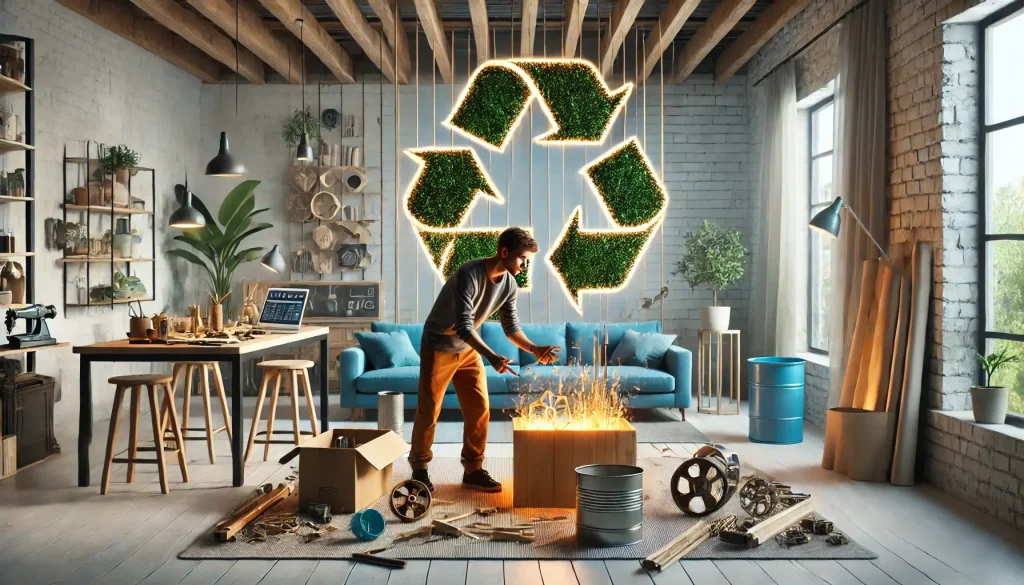In an age where environmental sustainability is a core value in design, we are witnessing a revolution that redefines home decor through the creative use of recycled materials. Today, to innover in decor means to push beyond traditional design boundaries and integrate cutting-edge recycled elements that not only add visual interest but also reduce environmental impact. At Eu Setor, we are committed to inspiring this movement by showcasing how innovative recycled materials can transform living spaces into modern, eco-friendly sanctuaries.

Index
The New Frontier in Eco-Conscious Decor
As designers and homeowners alike increasingly prioritize sustainability, the call to innover in the use of recycled materials has never been louder. The integration of advanced recycled materials in decor is transforming how we approach interior design. This new frontier is defined by several key elements:
- Technological Integration: New recycling technologies enable the transformation of waste into high-performance, aesthetically appealing decor materials.
- Material Innovation: From recycled plastics and metals to reclaimed glass and composite materials, innovation in recycled resources is driving a wave of fresh design ideas.
- Eco-Design Synergy: Merging artistic vision with environmental responsibility, cutting-edge recycled materials help create interiors that are both stunning and sustainable.
En choisissant de innover in decor, we take a definitive stand against the throwaway culture, embracing a circular economy where waste is converted into valuable resources.
Key Drivers of Innovation in Recycled Decor Materials
1. Advanced Recycling Technologies
Modern recycling methods have evolved significantly, enabling us to transform industrial and post-consumer waste into high-quality materials. Innovations such as chemical recycling, laser-assisted sorting, and advanced polymer processing have paved the way for recycled materials that rival, or even surpass, their virgin counterparts in performance and durability.
- Enhanced Material Properties: These technologies improve the strength, texture, and finish of recycled materials, making them ideal for modern decor applications.
- Sustainable Production Cycles: With more efficient recycling processes, the energy and water required to produce these materials are minimized, reducing the overall environmental footprint.
Par innovering through advanced recycling, we not only minimize waste but also create a supply chain that is both resilient and eco-friendly.
2. Recycled Plastics and Composite Materials
Recycled plastics have long been regarded as a waste management challenge. Today, however, they are at the forefront of sustainable design. Through processes that convert plastics into composite materials, designers can create decor items that are lightweight, durable, and versatile.
- Design Versatility: Recycled plastics can be molded into intricate shapes and textures, offering endless possibilities for decorative accents, furniture, and lighting.
- Des solutions rentables : Utilizing recycled plastics often reduces production costs, allowing for affordable yet high-quality design alternatives.
- Impact sur l'environnement : By diverting plastics from landfills and oceans, these recycled composites help address global plastic pollution while delivering modern aesthetics.
Innovative approaches to recycled plastics illustrate how we can innover within the design industry by transforming a global waste problem into beautiful, functional decor.
3. Reclaimed Metals and Glass
The resurgence of reclaimed metals and glass in decor is a testament to the timeless appeal of vintage materials reimagined through modern techniques. Reclaimed metals, such as aluminum and steel, are repurposed into sleek fixtures, decorative panels, and even structural elements in furniture. Similarly, reclaimed glass is now used in everything from tabletops to artistic installations.
- Artistic Expression: The natural patina and unique textures of reclaimed metals add an industrial yet elegant vibe to any space.
- Eco-Efficiency: Recycling metals and glass significantly reduces the energy consumption compared to extracting and processing new materials.
- Innovative Finishes: Modern treatment techniques, such as powder coating and digital etching, allow designers to customize reclaimed materials to suit contemporary aesthetics.
Pour innover in decor, we embrace reclaimed metals and glass as prime examples of how history and modernity can coexist in sustainable design.
4. Natural Fibers and Bio-based Composites
In addition to plastics, metals, and glass, natural fibers and bio-based composites represent an exciting area of innovation. Materials such as bamboo, hemp, and recycled cotton fibers are being engineered into high-performance composites that offer both sustainability and style.
- Renewable Resources: Natural fibers are inherently renewable, and when recycled, they help reduce the reliance on fossil-fuel-based materials.
- Biodegradable Options: Many bio-based composites are designed to be biodegradable, ensuring that they contribute to a closed-loop system where materials return to the earth without harm.
- Aesthetic Warmth: The organic textures and natural hues of these materials add warmth and an earthy sophistication to modern interiors.
En choisissant de innover with natural fibers, we underscore the potential of bio-based materials to reshape the future of eco-friendly decor.
Integrating Innovative Recycled Materials into Modern Decor
The next step in our journey is to explore practical strategies for incorporating these cutting-edge recycled materials into everyday decor. Whether you are a homeowner, an interior designer, or a business owner, there are several ways to integrate innovative recycled elements into your spaces.
Designing with Purpose
A successful eco-friendly design project starts with a clear vision and purpose. We recommend the following strategies to effectively innover your decor:
- Assess Your Needs: Evaluate which areas of your home or office could benefit most from sustainable updates. Consider both functional and aesthetic requirements.
- Select a Theme: Whether it is industrial chic, minimalist modern, or organic rustic, choose a design theme that aligns with your lifestyle and values.
- Balance New and Recycled: Integrate recycled materials with new, complementary elements. This balance not only creates visual interest but also highlights the unique story of recycled decor.
Showcasing Innovative Pieces
Innovative recycled decor pieces often serve as statement elements that capture attention and spark conversation. Consider these applications:
- Feature Walls: Use reclaimed wood, metal, or composite panels to create a dramatic feature wall that acts as the focal point of a room.
- Custom Furniture: Invest in or create furniture that incorporates recycled plastics or bio-based composites. Unique designs like these not only offer functionality but also make a bold style statement.
- Lighting Solutions: Upcycled lighting fixtures made from reclaimed metals and glass can cast an ambient glow while underscoring your commitment to sustainability.
- Accents and Accessories: Small decorative items—such as vases, planters, and artwork—crafted from innovative recycled materials add subtle touches of eco-friendly elegance throughout your space.
Case Studies and Success Stories
Real-world examples illustrate how innovative recycled materials are reshaping the world of decor:
Modern Office Space Transformation
A contemporary office recently underwent a transformation by integrating recycled composite furniture and reclaimed metal fixtures. The use of recycled plastics in modular desks and chairs not only improved the workspace’s ergonomics but also reduced the overall carbon footprint. The project demonstrated that by choosing to innover with recycled materials, businesses can create an inspiring environment that aligns with sustainability goals while promoting employee well-being.
Urban Residential Renovation
In an urban residential project, reclaimed glass and bio-based composites were used to create custom kitchen countertops and backsplashes. The unique interplay of textures and finishes resulted in a kitchen that felt both modern and timeless. This renovation highlights how homeowners can innover their decor by seamlessly blending recycled elements with high-end design.
Eco-Friendly Retail Environment
A boutique retail store embraced innovation by designing its interior with a mix of reclaimed wood, recycled metal fixtures, and custom-made furniture from recycled plastics. The result was a store that exuded eco-chic sophistication, attracting environmentally conscious consumers and setting a new benchmark for sustainable retail design. This case underscores the commercial potential of innovering with recycled materials to create compelling, marketable spaces.
Challenges and Opportunities in Innovating with Recycled Materials
While the potential for innovation in recycled decor is vast, several challenges must be addressed to fully realize its benefits:
Supply Chain and Material Consistency
- Défi : The availability and consistency of high-quality recycled materials can be unpredictable.
- Opportunity: Collaborating with specialized suppliers and local recyclers can help ensure a steady supply of innovative materials. Investment in research and development further enhances material quality and consistency.
Cost Considerations
- Défi : Although recycled materials can be cost-effective, initial setup and processing costs may be higher than those for mass-produced items.
- Opportunity: Long-term savings in energy consumption, waste reduction, and maintenance often offset these initial investments. Moreover, as technology advances, the cost of producing innovative recycled materials is expected to decrease.
Consumer Perception and Market Education
- Défi : Some consumers may be hesitant to adopt recycled decor due to preconceived notions about quality or style.
- Opportunity: Educating the market through transparent communication, success stories, and demonstrations of quality can shift perceptions. As more high-profile projects showcase the benefits of recycled materials, consumer acceptance will grow, driving broader market trends.
Innovation in Design Processes
- Défi : Traditional design practices may need to be rethought to fully integrate innovative recycled materials.
- Opportunity: Embracing digital design tools and collaborating with interdisciplinary teams—including engineers, material scientists, and designers—can foster a culture of innovation. This collaboration not only improves product quality but also leads to groundbreaking new applications in decor.
The Future of Innovative Recycled Decor
Looking ahead, the potential to innover with recycled materials in decor is boundless. Several emerging trends are likely to shape the future of eco-friendly design:
Fabrication numérique et personnalisation
Advances in digital fabrication technologies, such as 3D printing and laser cutting, are revolutionizing how recycled materials are processed and customized. These tools enable precise and efficient manufacturing processes that can create bespoke decor pieces tailored to individual tastes and spatial requirements.
Intégration avec les technologies de la maison intelligente
The next generation of recycled decor will likely incorporate smart home features, such as energy-efficient lighting systems, sensor-driven art installations, and interactive design elements. These innovations will not only enhance functionality but also create immersive, eco-friendly environments.
Projets collaboratifs et communautaires
As the demand for sustainable design grows, community-driven projects and collaborative workshops will play a significant role in inspiring innovation. By sharing resources, ideas, and skills, communities can drive the widespread adoption of recycled materials in decor, transforming neighborhoods and commercial spaces alike.
Circular Design and Lifecycle Thinking
Future innovations will emphasize the entire lifecycle of materials—from design and production to end-of-life reuse. Circular design principles will ensure that every decor piece can be reintegrated into the supply chain, continuously innovering not only in aesthetics but also in sustainability.
Conclusion: Embrace the Power to Innovate
Le mouvement pour innover using cutting-edge recycled materials in decor represents a dynamic fusion of sustainability, technology, and creative design. By reimagining waste as a resource and embracing advanced recycling technologies, we can transform everyday items into striking decor that enhances our living environments and supports a greener future.
At Eu Setor, we are passionate about championing this innovative approach. We believe that every project, whether it is a modern office space, a chic residential renovation, or an eco-friendly retail environment, demonstrates the transformative power of recycled materials. As we continue to innover in the field of eco-friendly design, we invite you to join us on this exciting journey. Explore new materials, experiment with innovative techniques, and create spaces that are not only aesthetically compelling but also a testament to environmental responsibility.
Pour plus d'informations, de guides de projets et d'inspiration en matière de conception durable, veuillez consulter notre site web à l'adresse suivante eu.setorreciclagem.com.br and become part of the Eu Setor community. Together, let us innover our way to a future where every design choice contributes to a sustainable, vibrant, and truly transformative world.
